Google Pixel 7 Pro vs Pixel 7: Not just about the size of it
We may earn a commission if you make a purchase from the links on this page.
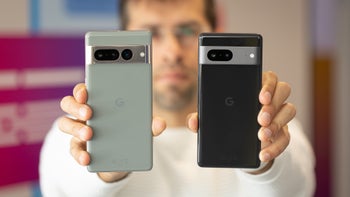
Intro
Google's latest flagship Pixel 7 series aims to build upon and improve on everything that made the Google Pixel 6 and Google Pixel 6 Pro such an important milestone for Google. Big G outgrew its Pixel 5-hiatus and is now back to annual flagship releases.
The Pixel 7-series aims to reiterate that Google is back on track and is more than willing to re-carve its space on the flagship market, an excellent vantage position to comfortably deliver well-timed punches to Samsung, Apple, and pretty much any other phone manufacturer out.
Of course, it's clear that the Pixel 7 Pro is the more advanced device with the more versatile camera and larger display and battery, but that might not be necessarily true for just about anyone. If anything, the Pixel 7's newfound, slightly more compact size in comparison with yesteryear's Pixel 6 and the Pixel 7 Pro means that it would be a much better fit for those wanting for a more manageable handset.
Google's latest strategy doesn't focus on trading raw performance blows with the competition, but puts the emphasis on user experience... and artificial intelligence, the buzzword that's all the rage these days. So far, so good, but which of Google's new flagships is a better fit for you, the Pixel 7 or the Pixel 7 Pro? Does one size fit all or is there any big difference between the two?
The Google Pixel 8 and Google Pixel 8 Pro are also here. The newest Pixel generation introduced a ton of spectacular improvements to both hardware and software. The Pixel 7 Pro specs are mostly the same as the Pixel 7 specs, but this doesn't mean the experience is the same. Let's explore the intricate details!
Google Pixel 7 Pro vs Google Pixel 7 in a nutshell:
| Pixel 7 Pro | Pixel 7 |
|---|---|
| 6.7-inch QHD+ LTPO (1-120Hz) display | 6.3-inch FHD+ 60-90Hz (LTPS) display |
| 128GB, 256GB, 512GB storage versions | 128GB, 256GB storage versions |
| 12GB LPDDR5 RAM | 8GB LPDDR5 RAM |
| 5,000mAh battery | 4,270mAh battery |
| 23W wired charging, 23W wireless charging w/ Pixel Stand | 20W wired charging, 20W wireless charging |
| 48MP 5.0X telephoto camera | - |
| Ultra-wide with 125° FoV | Ultra-wide with 114° FoV |
| $899 | $599 |
Table of Contents:
Read more:
- Google Pixel 7 review
- Google Pixel 7 Pro review
- Google Pixel Fold Review: finally, a folding phone you can enjoy using even without unfolding
- Google Pixel 8 Pro vs Pixel 7 Pro: Nothing new under the sun
- Google Pixel Fold vs Pixel 7 Pro: foldable phone pros and cons
- Google Pixel 7 Pro vs iPhone 14 Pro Max: main differences
- Google Pixel 7a vs Pixel 7: what are you compromising with the cheaper 7a?
- Samsung Galaxy S23 Ultra vs Google Pixel 7 Pro: the battle of Androids
Design and Display Quality
Shared DNA

The main difference between the Pixel 7 Pro and Pixel 7 is their overall size, which naturally stems a few important differences from itself. Frankly speaking, the size discrepancy between the two phones isn't that big, but the couple of millimeters here and there are enough to give the Pixel 7 Pro a larger, 6.7-inch display, a bigger 5,000mAh battery, and one extra camera in comparison with the 6.3-inch Pixel 7, which has its more compact size as the main selling point.
From a pure design standpoint, both phones are mostly identical—aluminum and glass sandwiches reiterating the general looks of last year's Pixel 6-series, which sit exceptionally comfortable in the palm of your hand. Unlike the 2021 Google flagships, however, the camera strips of the Pixel 7 and Pixel 7 Pro aren't black glass bars, but a deliberate design element that connects with the side frame of the phone and is colored in a complementary hue.
This makes the camera lenses at the back clearly visible, which is a bold design statement that immediately makes the Pixel 7 lineup more discernible in comparison with the Pixel 6 family. However, there's a purely aesthetic downside to all that—the aluminum camera strip of our Pixel 7 Pro unit has already scratched and scuffed a bit in just a few days of regular usage, which isn't exactly inspiring confidence.
There's a rather noticeable lip where the display meets the side frame, a bit more pronounced on the Pixel 7 Pro, which might not be everyone's cup of tea. It's not aggravating, but definitely sharper than expected, and it requires some getting used to. Having a case with a slightly raised lip would certainly fix that slight shortcoming.

The Pixel 7 and Pixel 7 Pro also drop the dual-tone back design, where the glass section immediately above the camera strip was showcasing a lighter hue in contrast to the darker bottom section. Speaking of Pixel 7 colors, another difference between the duo are the colors in which they are available. The all-time classic Obsidian (black) and Snow (white) colors are available on both devices, but the Pixel 7 Pro scores a unique Lemongrass color option (gray/green) with a gold camera bar, while the regular Pixel 7 has a playful Hazel color option in store for us (a very soft green hue that looks super-fresh).
Both phones have IP68 water- and dust-resistance, stereo speakers, and dual SIM capabilities (nano SIM + eSIM). The biometric security of choice is a under-display fingerprint scanner on both devices, and there's a convenient but not very secure 2D face unlock.
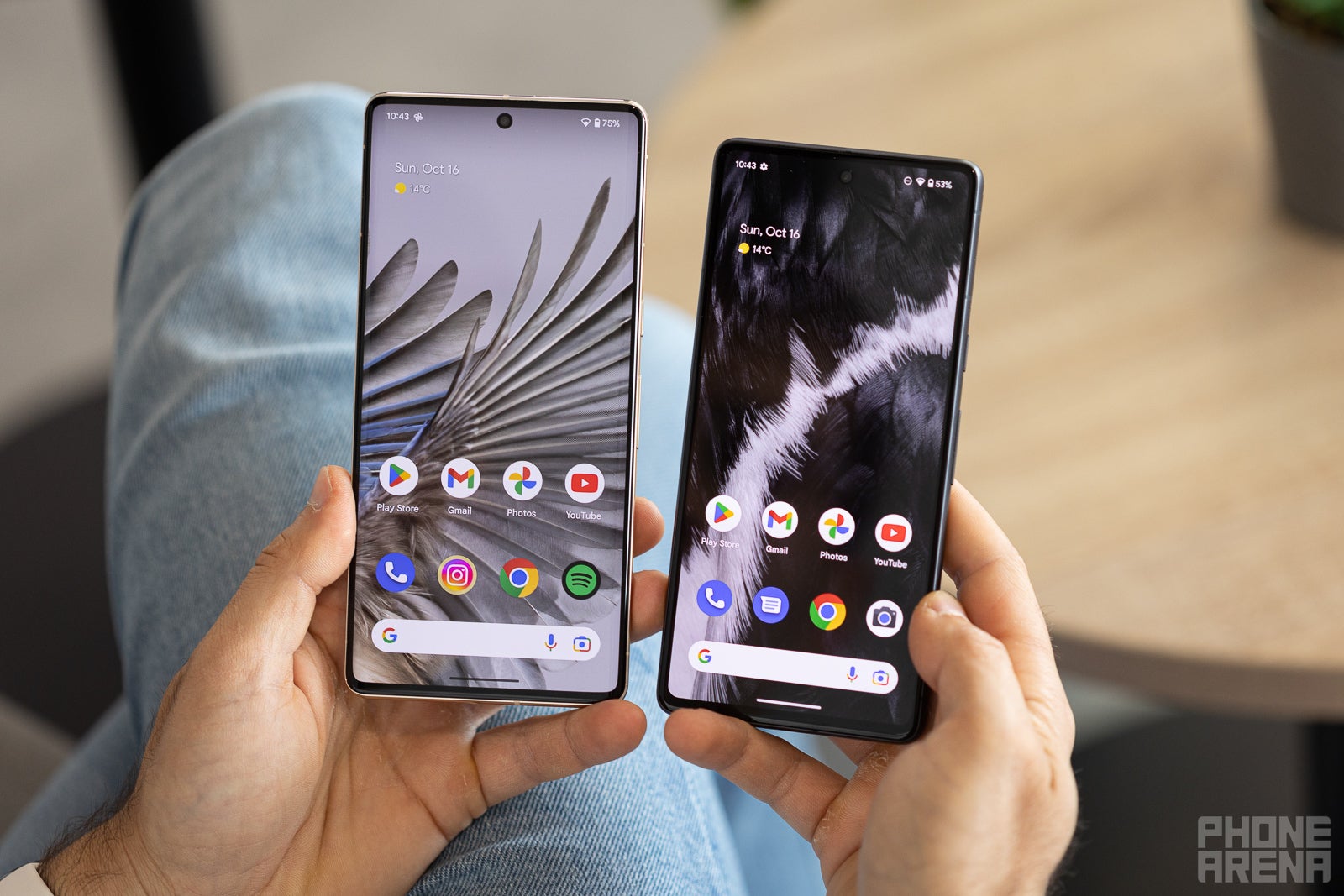
Display-wise, the mainstay difference from the Pixel 6 family carries on. The Pixel 7 Pro comes with a large, 6.7-inch QHD+ OLED display with a 1-120Hz refresh rate, with an ever-so-slight curve near the edges, while the Pixel 7 arrives with a 6.3-inch FHD+ OLED display with a 60/90Hz refresh rate. The latter is completely flat, similar to the one on the Pixel 6.
From a purely quality perspective, the duo is outfitted with excellent OLED displays that are bright and vivid, and certainly a pleasure to look at.
The minimum and maximum brightness, as well as the overall color temperatures are mostly similar on both phones, and so are viewing angles. The biggest difference you might not even notice is the maximum refresh rates of the two displays. While the Pixel 7 Pro has a 1-120Hz display, which is super smooth, the Pixel 7 "only" gets to work in either 60 or 90Hz. While it may sound like a game-changing difference, it isn't. Scrolling on both is quite smooth, and you might not be able to detect a difference even if you scroll the two displays side-by-side. So, screen refresh rate shouldn't be among the top reasons why you should consider the Pixel 7 Pro.
Performance and Software
Tensor G2 runs the show
Both the Google Pixel 7 and Pixel 7 Pro are powered by the second-gen Tensor G2 chipset, which builds upon the Tensor G1 in a meaningful way—by continuing the push with machine learning and artificial intelligence. The Tensor hasn't become a powerhouse, and it is still well behind in terms of raw performance in comparison with its closest Qualcomm and Apple rivals, but the chipset has scored a slight performance increase over the pioneering Tensor chip inside the Pixel 6-series.
Is that merely enough, though? For regular usage, yes, neither feels slow nor unresponsive. In fact, it's a pleasure using either phone, and you might only feel a certain lack of horsepower in very specific scenarios. Overall, the Pixel 7 and Pixel 7 Pro are good performers.
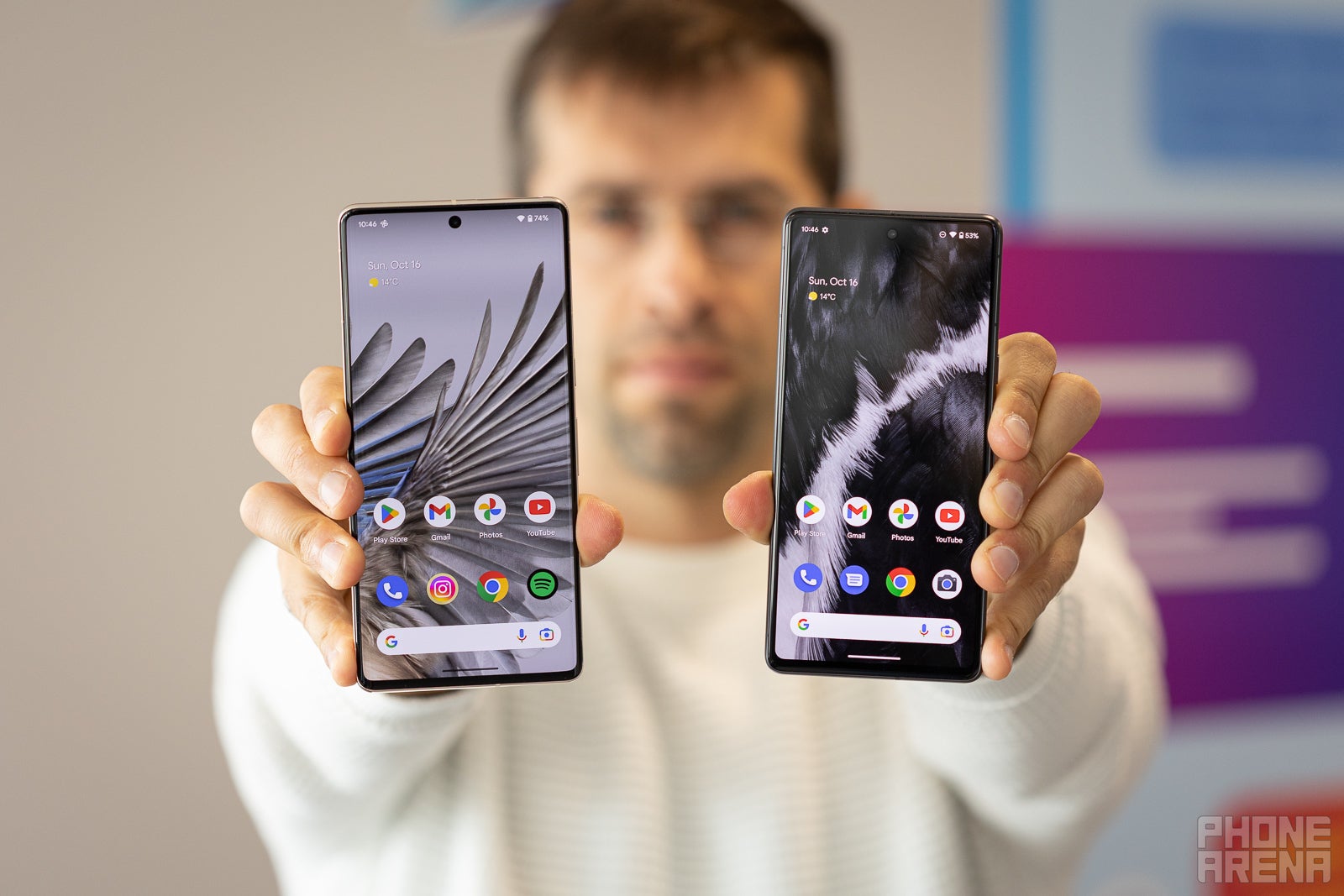
The deal with the custom-made Google Tensor is that it relies rather heavily on artificial intelligence and machine-learning, a different approach in comparison with, say, the Qualcomm Snapdragon 8+ Gen 1 or the Apple A16 Bionic, which are putting way more faith in raw performance. Thanks to its AI and ML capabilities, the Tensor allows for some intriguing camera features to be available on the Pixel 7 and Pixel 7 Pro.
Google says that some other features that the Tensor unlocks are better efficiency in comparison with the Tensor G1 in the Pixel 6-series, which should lead to better battery life, Cinematic Blur that is processed in real-time, intelligent speech recognition and better text dictation, as well as great on-device security ensured by the Titan M2 security chip.
Memory and storage-wise, we get 12GB of RAM on the Pixel 7 Pro and 8GB of RAM on the Pixel 7. Those figures are pretty standard and should be more than sufficient for just about any Pixel user. In any case, multitasking on either phone is pretty adept, and you either have to be a rather extreme power user or intentionally try to juggle between ten or more apps at the same time to start noticing spontaneous app reloads.
Performance Benchmarks:
Storage-wise, we have another key difference between the Pixel 7 and the Pixel 7 Pro. See, the small Pixel 7 is available with either 128GB or 256GB on deck, whereas its big brother gets an additional 512GB version on top of that, which should jibe well with power-users.
Alas, none of Google's new phones get microSD card expansion slots, so there are no additional options for hardware storage expansion. Google Photos is a great alternative to hardware photo storage, but you have to opt for the premium storage tiers.
Camera
To telephoto or not to telephoto?
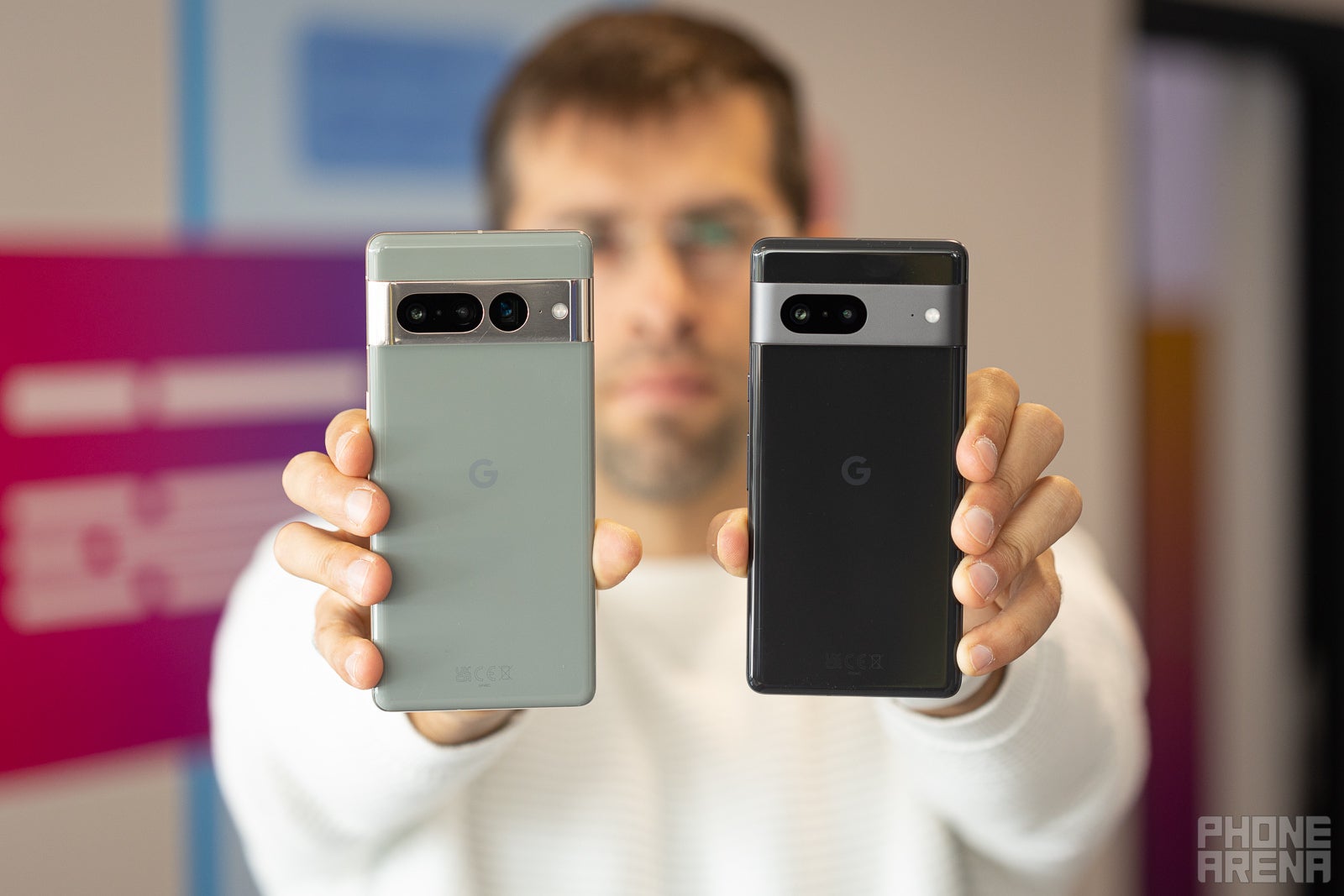
The big difference in the camera department stems from the 5X telephoto camera found on the Pixel 7 Pro. It heavily relies on the AI and ML capabilities of the Tensor G2 to deliver unprecedented (for a Pixel) levels of zoom that don't compromise the image quality. Thanks to the 48MP 5X telephoto camera, the Pixel 7 Pro allows for a 30X hybrid zoom. The telephoto camera offers preset zoom levels at 2X, 5X and 10X zoom levels, but you can go well beyond that.
Common features of both the Pixel 7 and Pixel 7 Pro are the following:
- Photo Unblur — Thanks to this feature, the Google Photos app on both new Pixels allows the user to quickly unblur and sharpen an image with just a tap.
- Magic Eraser — This well-known AI-driven software feature gets rid of distractions and photobombers in your images. You can also change the colors and brightness of a subject so that it fits better into your existing image.
- Real Tone — Google 's quest to making its hardware more inclusive has led it to take thousands of pictures of people of color so as to fine-tune the camera and correctly represent non-white skin tones. The new Pixels recognize a broader set of faces, correctly represent skin color in photos, make skin brightness appear more natural than before, reduce washed-out images, sharpen faces even in low light, and provide you with a smarter auto-enhance in Google Photos.
- Cinematic Blur — Similar to the iPhone's Cinematic mode, the new Pixels let you take videos with an artificially blurred background while keeping your subjects in focus for that much-coveted dramatic effect.
- Wider front camera — Both devices now have wider 10.8MP selfie cameras with faster f/2.2 aperture.
Meanwhile, it's the hardware limitations that only allow the Pixel 7 to employ up to 8X hybrid zoom. This one uses information from the main 50MP camera of the smaller phone and uses pixel-binning to achieve image quality equivalent to 2X optical zoom. As we mentioned, up to 8X digital zoom can be achieved on the Pixel 7.
Another Pixel 7 Pro-exclusive feature is Macro Focus, which uses the ultra-wide angle camera's extremely narrow focusing distance to achieve super-detailed images. It's an extremely notable feature if you're into macrophotography.
When it comes to the pure hardware side of things, here's a complete rundown of the Pixel 7 Pro/Pixel 7 camera specs:
- 50MP wide, f/1.85
- 12MP ultra-wide, f/2.2 (125.8° FoV on Pixel 7 Pro, 114° on Pixel 7)
- 48MP 5X zoom telephoto (only on Pro model)
- 10.8MP f/2.2 front camera
Image quality
Are all the hardware differences above enough to warrant a significant image quality disparity?
Well, the main camera outputs very similarly looking images due to the similarities in hardware. Both have excellent dynamic range and superb color rendition that brings out the best in your subject while looking as realistic as possible. Pixel 7 and 7 Pro photos also stand out with their distinct gritty, moody, and slightly underexposed look, which sets them apart very well from, say, an iPhone or a Galaxy, which generally produce warmer and more mass-appealing photos.
Pixel 7 Pro vs Pixel 7 daylight camera samples
Google Pixel 7 Pro vs Pixel 7 ultra-wide camera samples
When it comes to the ultra-wide cameras, both snappers might be 12MP ones, but the one on the Pixel 7 Pro is much wider, and therefore much more usable. It has a significantly wider 125-degree field of view in comparison with the 114-degree one on the Pixel 7, which might not sound like much, but in reality stands as a stark difference between the two. You don't gain that much by switching to the wide-angle camera on the Pixel 7, but you do with the Pixel 7 Pro.
And zooming in is one of the areas in which the Pixel 7 Pro can't really be touched by the Pixel 7. As a comparison, here's what a maximum zoom battle between the two Pixels, at 30x and 8x respectively, looks like. From a quality perspective, using the maximum digital zoom of the Pixel 7 is challenging to recommend, seeing how it has turned the image into a watercolor painting with barely legible details, but that's to be expected of such long digital zoom, which uses a tiny fraction of the camera sensor.
Audio Quality
Both the Pixel 7 and the Pixel 7 Pro sport very decent stereo speakers. Admittedly, both exhibit similar sound quality, with clear and punchy mids, though the base frequencies lack that extra oomph an iPhone or a Galaxy could get you. Still, the sound is extremely enjoyable, and we doubt anyone will have an issue with how each of Google's new Pixels sounds.
Battery Life and Charging
While it may seem that the larger battery of the Pixel 7 Pro would give it much better battery life in comparison with the Pixel 7, in reality the two phones are pretty comparable when it comes to real battery life. And come to think of it, that's somewhat logical: the Pixel 7 has a smaller battery, true, but it also has a smaller display with a lower resolution and maximum refresh rate, which definitely helps with equalize the playing field with the larger Pixel 7 Pro, with its larger and hungrier QHD+ display.
In our custom battery tests, which involve automated web surfing and scrolling over a Wi-Fi network at 200 nits of pre-set screen brightness, both devices score very close results. The Pixel 7 Pro has the upper hand in our video streaming and web browsing tests with a slight edge over the Pixel 7, but the latter takes one point back in our 3D gaming benchmark, where it lasted half an hour more than the larger Pixel.
PhoneArena Battery Test Results:
That said, both phones can last more thanks to the customizable Extreme Battery Saver feature, which promises up to 72 hours of combined usage. How does it achieve that? It does so by pausing notifications for all apps except those you've greenlit and a few essential ones, toning the display refresh rate to 60Hz, turning 5G off, and hampering the overall performance of the phone. It's not a mode that you'd want to use all the time, but in those clutch use scenarios where you're away from a charger, it could very well be the difference between a functional and a dead phone.
Charging-wise, the Pixel 7 Pro supports 23W wired and wireless charging, while the Pixel 7 supports both wired and wireless 21W charging. The Pixel 7 Pro takes nearly an hour and half to charge fully.
Specs Comparison
How does the Pixel 7 Pro and Pixel 7 stack up against one another? Let's check in our dedicated Pixel 7 vs Pixel 7 Pro specs comparison:
| Specs | Pixel 7 Pro | Pixel 7 |
|---|---|---|
| Dimensions | 162.9 x 76.6 x 8.9 mm | 155.6 x 73.2 x 8.7 mm |
| Weight | 212gr | 195gr |
| Screen | 6.7-inch, 1-120Hz, QHD+ OLED, Gorilla Glass Victus | 6.3-inch, 60-90Hz, FHD+ OLED, Gorilla Glass Victus |
| Processor | Tensor G2 | Tensor G2 |
| RAM & storage | 12GB LPDDR5, 128GB/256GB/512GB UFS 3.1 | 8GB LPDDR5, 128/256GB UFS 3.1 |
| Rear Cameras | 50MP wide-angle f/1.85 main (30X Super Res Zoom) 12MP ultra-wide angle f/2.2 48MP 5X telephoto F2.2 Laser auto-focusing | 50MP wide-angle f/1.85 (8X Super Res Zoom) 12MP ultra-wide angle f/2.2 Laser auto-focusing |
| Front Camera | 10.8MP f/2.2 | 10.8MP f/2.2 |
| Battery Size | 5,000mAh, >24-hour battery life, Up to 72 hours with Extreme Battery Saver | 4,355mAh, >24-hour battery life, Up to 72 hours with Extreme Battery Saver |
| Charging Speeds | 23W fast wired charging (50% in 30 min), 23Wfast wireless charging, battery share | 20W fast wired charging (50% in 30 min), 20W fast wireless charging, battery share |
| Price | $899 | $599 |
Summary and Final Verdict
Overall, we remain quite optimistic about the Pixel 7 Pro and the Pixel 7. Both devices seem to be reiterating Google's desire to carve a niche for its flagship wares, with the Pixel 7 and the Pixel 7 Pro improving most of the key aspects that made the Google Pixel 6 and Pixel 6 Pro such noteworthy devices.
Well, the good news is that if you've liked the Pixel 6 and Pixel 6 Pro, the Pixel 7-series seems to be more of the same, but better, which can never be a bad thing! With a refreshed Tensor chipset on deck, which shows us Google's commitment to its custom silicon, tons of camera improvements, and at the same time—unchanged pricing—the Pixel 7 and Pixel 7 Pro are definitely winners at their game.
Surely, they are also among the very best Android phones you can get right now, and you shouldn't pass up the opportunity to score one of those during the upcoming Black Friday sales festival.
On the other hand, if compact Android phones are your weakness, and you don't really care about zooming that much, then the slightly smaller size (and price tag) of the Google Pixel 7 could definitely tip the scales in its favor. Surely, it shares the majority of new features that the Pixel 7 Pro also boasts, sans the exclusive camera ones. And overall, it is a pretty capable device, a phone that brings the best of Google at your fingertips.
Which one should you choose? Surely, if you're looking for a larger and sharper display, bigger battery, and that sweet, sweet 30X Super Res Zoom, as well as the complete flagship experience, it makes perfect sense to go for the Google Pixel 7 Pro.




















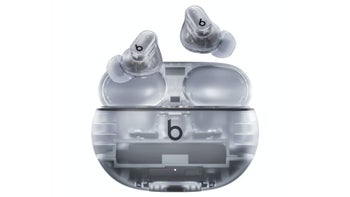






Things that are NOT allowed: